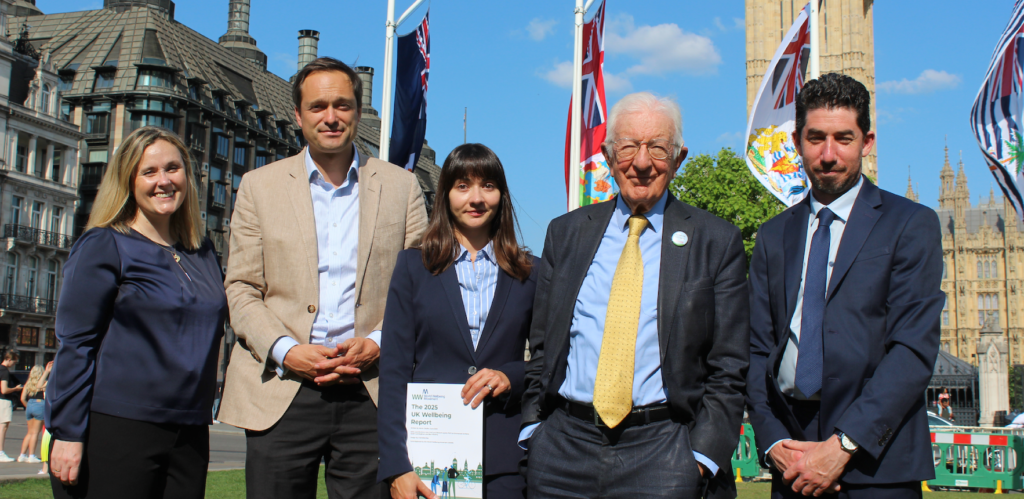18.06.2025 | 4 read
UK Wellbeing Report 2025: Nearly 7 million UK people estimated to be living below the Happiness Poverty Line
The number of UK people living below the Happiness Poverty Line is rising, according to alarming new findings published today (Wednesday) by the World Wellbeing Movement.- Nearly 7 million UK people – around 13% of the population aged 16 and above – are estimated to be living below the Happiness Poverty Line.
- Happiness in the UK continues to remain below pre-pandemic levels: average life satisfaction is lower, more people live below the Happiness Poverty Line, and fewer people are flourishing.
- An additional 650,000 UK people are estimated to have fallen below the Happiness Poverty Line since the first UK Wellbeing Report.
The number of UK people living below the Happiness Poverty Line is rising, according to alarming new findings published today (Wednesday) by the World Wellbeing Movement.
Using the latest annual life satisfaction data1 made available by the Office for National Statistics (ONS), the 2025 UK Wellbeing Report estimates that an additional 650,000 UK adults – enough to fill Wembley Stadium more than seven times – have fallen below the Happiness Poverty Line compared to the previous 12 months2.
The World Wellbeing Movement defines the Happiness Poverty Line as those who rate their satisfaction with life at 5 or below on the 0-10 scale reported by the ONS.
Around 7 million adults across the UK are now estimated to be living in happiness poverty: equivalent to more than the entire population of Scotland, and around 13% of the UK population aged 16 and older. This proportion is roughly equivalent to those who live in absolute income poverty in the UK, a parallel that led us to coin the term ‘living below the Happiness Poverty Line’ in our inaugural March 2024 report.
Of the home nations, Wales has the highest proportion of residents living below the Happiness Poverty Line (15%) and Northern Ireland has the lowest (12%).
Worryingly, the gradual improvements in average UK wellbeing levels observed before the Covid-19 pandemic have been erased. Prior to 2020, the proportion of people living below the Happiness Poverty Line was falling year on year – despite an initial recovery in 2022, that trend has since reversed.
And the latest quarterly figures released by the ONS in May confirm that this stagnation extends into at least the last quarter of 2024.
For the first time, the UK Wellbeing Report this year also reports the number of people living above the ‘Flourishing Line’ – those who rate their lives as a 9 or 10 out of 10.
The gap between the proportion of people living below the Happiness Poverty Line and those living above this Flourishing Line has also grown slightly over the same period, suggesting a widening gap between the best-off and worst-off in society.
The World Wellbeing Movement is working alongside a cross-party group of Parliamentarians and other policy experts to better understand and address the conditions required to build better lives, and is calling for the UK Government to put the wellbeing of people at the heart of decision-making.
Prof Lord Richard Layard, co-founder of the World Wellbeing Movement and Professor of Economics at the London School of Economics and Political Science, said:
“People are still less satisfied with their lives than before the pandemic. That is a real challenge. But it is encouraging that the government’s approach to spending is now – in principle – based on its impact on life satisfaction. That is what we need for the future.”
Sarah Cunningham, Managing Director of the World Wellbeing Movement, said:
“These concerning findings are a sign that too many people are struggling in their day-to-day lives. The reality of these figures, and the human faces and stories they represent, should act as a wake-up call. If we are serious about improving lives and reducing inequality, we need to put wellbeing at the heart of decision-making in public policy.”
Dr Maria Cotofan, Lecturer in Economics and Policy at King’s College London and author of the 2025 UK Wellbeing Report, said:
“There are already substantial differences in happiness across areas in the UK, and happiness appears to be stagnating below pre-pandemic levels, regardless of how we measure it. What we don’t yet understand well enough is why this is the case, but this is a crucial question for these communities.
“In order to understand how to improve happiness we need better data on what matters to people in these areas. To actually improve happiness, we need decisive leadership in terms of policies that improve wellbeing.”
The 2025 UK Wellbeing Report, published by the World Wellbeing Movement, is available in full at worldwellbeingmovement.org/uk-wellbeing-report.
- Latest area-level life satisfaction data published by the ONS covers the period April 2022 to March 2023.
- Compared to the period April 2021 to March 2022.
Image: Sarah Cunningham, Prof Jan-Emmanuel De Neve, Dr Maria Cotofan, Prof Lord Richard Layard, and Ben Wealthy pose with the 2025 UK Wellbeing Report in front of the Palace of Westminster. Credit: World Wellbeing Movement
